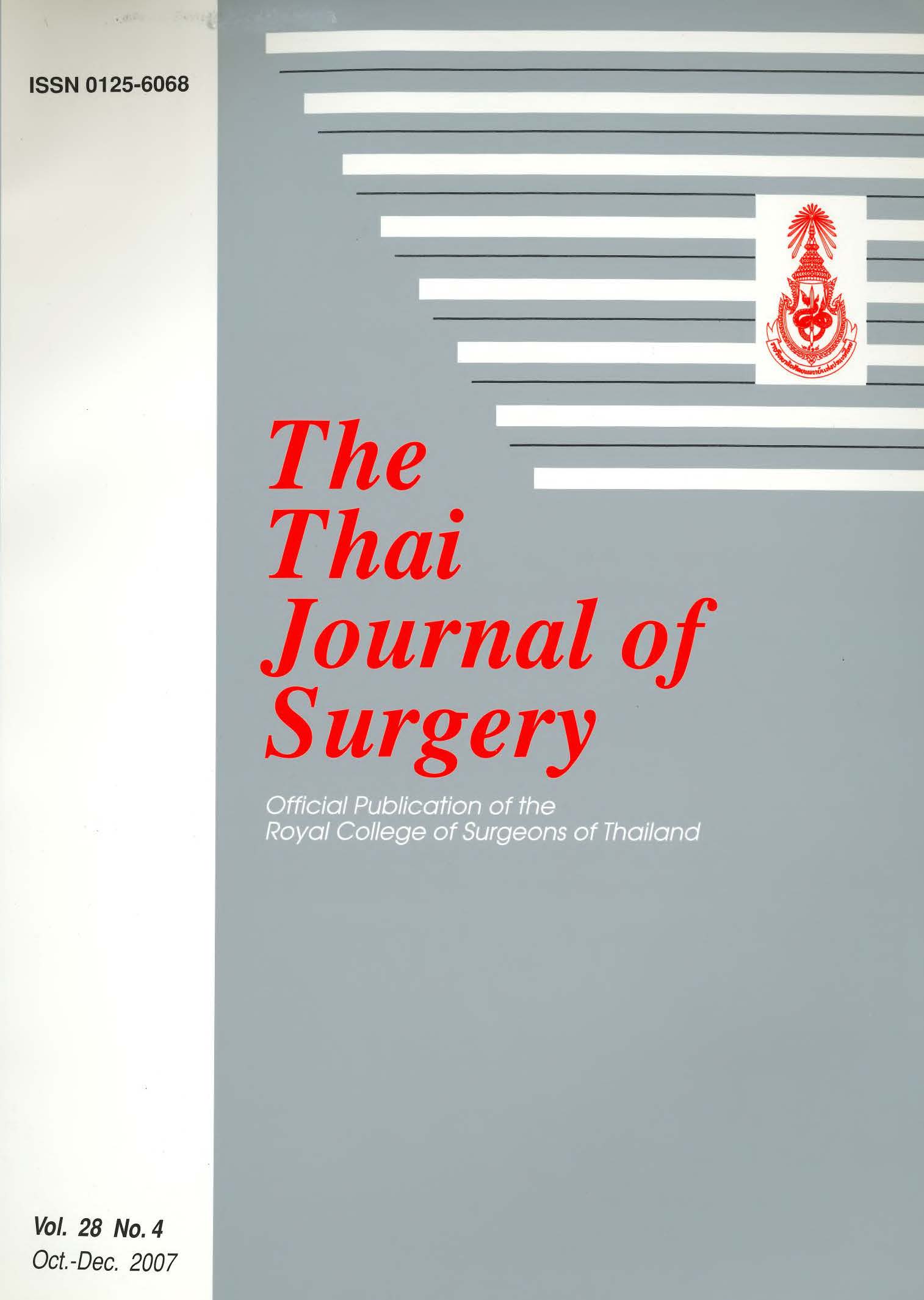Trauma during Pregnancy: A Review of 38 Cases
Abstract
Introduction: The emergency care of trauma patients who are pregnant is challenging due to the anatomy and physiological changes during pregnancy. Maternal trauma is the leading non-obstetric cause of fetal death. The objective of this study was to review the problems and to present findings, decision making and management.
Materials and Methods: Medical records of 38 trauma women with secondary diagnosis of pregnancy admitted to Suratthani Hospital during September 30, 2002 and September 30, 2005 were reviewed. Vital signs, coma scores, fetal heart rates, diagnostic peritoneal lavage (DPL) results, operative findings and clinical courses were extracted. Information on pregnancy outcome and the use of seat belt were obtained. An injury severity score (ISS) was calculated in all patients. Gestational age was determined. DPL was employed using a supraumbilical approach.
Results: The mean age of 38 pregnant women was 21 years. Ten percent were in the first trimester, 40% in the second trimester and 50 % in the third trimester. The majority was blunt trauma. Thirty pregnant women obtained collision injuries (19 by motorcycle and 11 by automobile), 5 from fall and 3 from gunshot wound, body assault, and snake bite. The mean ISS was 10.5. There were 4 maternal deaths (10.52%). Four fetal deaths were in utero (FDIU). 'The pregnancy outcome could be recorded in 31 (81.5%) of 38 patients; g of 31 fetuses were dead (4 FDIU with maternal death and 5 spontaneous abortions). Fetus was alive in 22 patients (71%). The outcome could not be evaluated in 7 of 38 patients due to loss of follow-up. Six patients were admitted with evidence of shock resulting in 4 maternal and 4 fetal deaths (66.6%). There was no maternal mortality in patients with normal vital signs, however, fetal loss occurred in 5/32 (15.6%). DPL was performed in 6 patients suspected of having blunt abdominal trauma. DPL was considered positive in 5 patients (83.4%) and negative in I patient (16.6%), All positive results were confirmed by laparotomy finding. Information on the use of seat belt was available in 11 automobile collisions; 3 patients (27.3%) were wearing restraints, 8 patients were unrestraint and 4 of them (50%) died. Moreover, uteroplacental injuries were noted in patients who were wearing belts and one injury was reported in the unbelted occupants. Helmet wearing was reported in 19 patients. Four patients with helmets use were significantly injured. Among 15 patients who did not use helmet, 3 patients sustained major injury, 6 patients had minor injury and other 6 patients had significant injury. The GCS of all 19 patients were 15 which were not significantly different.
Conclusions: The net effect of trauma on pregnancy outcome depends in a great extent on physicians' awareness of the altered intra-abdominal injury pattern in pregnant women. Moreover, the outcome also depends on the awareness of the hematological changes of pregnancy and, most importantly, the physician's ability to promptly diagnose and treat maternal injury. The overriding principle in the management of injured pregnant woman is that maternal well being is paramount. The best chance for fetal survival is to assure the maternal survival.
References
2. Hakanson EY. Trauma to the female genitalia. Lancet 1966; 86:287-91.
3. Greenspan L, Mclellan BA, Greig H. Abbreviated injury scale and Injury Severity Score: a scoring chart. J Trauma 1985;25:60-4.
4. Cox EF, Dunham CM. A safe technique for diagnostic peritoneal lavage. J Trauma 1983; 23: 152-4.
5. Peckman C, King R.A study of intercurrent conditions observed during pregnancy. Am J Obstet Gynecol 1963; 87:609-24.
6. Lavin JP, Polsky S. Abdominal trauma during pregnancy. Clin Perinatol 1983; 10: 423-38.
7. Rothenberger D, Quattlebaum FW, Perry JF Jr, Zabel J, Fischer RP. Blunt maternal trauma: a review of 103 cases. J Trauma 1987; 18:173-9.
8. Crosby WM, Costiloe JP. Safety lap belt restraints for pregnant victims of automobile collisions. N Engl J Med 1971; 284: 632-6.
9. Timberlake GA, McSwain NE Jr. Trauma in pregnancy: a 10-year perspective. Am Surg 1989; 55: 151-3.
10. Cruikshank DP. Anatomic and physiologic alterations of pregnancy that modify the response to trauma. In: Buchsbaum HJ, editor. Trauma in pregnancy. Philadelphia, PA: WB Saunders; 1979. p. 21-39.
11. Griess F. Uterine vascular response to hemorrhage during pregnancy. Obstet Gynecol 1966; 27: 408-13.
12. Hoff WS, D'Amelio LF, Tinkoff GH, et al. Maternal predictors of fetal demise in trauma during pregnancy. Surg Gynecol Obstet 1991; 172:175-80.
13. Bivins BA, Sachatello CR, Daugherty ME, Ernst CB, Griffin WO. Diagnostic peritoneal lavage is superior to clinical evaluation in blunt trauma. Am Surg 1978; 44:637-41.
14. Fisher RP, Beverlin BC, Engrav LH, Benjamin Cl, Perry JF. Diagnostic peritoneal lavage fourteen years and 2,586 patients later. Am J Surg 1978;136: 701-4.
15. Petrucelli E. Seat belt laws: the New York experience - preliminary data and some observations. J Trauma 1987;27: 706-10.
16. Evan L. Fatality risk reduction from safety belt use. J Trauma 1987;27:746-9.
17. Crosby WM. Pathology of obstetrical injuries. In: Brink-house KM, editor. Accident pathology. Washington, DC: Government Printing Office; 1970. p. 204-17.
18. Crosby WM, King Al, Stout LC. Fetal survival following impact: improvement with shoulder harness restraint. Am J Obstet Gynecol 1972; 112:1101-6.
Downloads
Published
How to Cite
Issue
Section
License
Articles must be contributed solely to The Thai Journal of Surgery and when published become the property of the Royal College of Surgeons of Thailand. The Royal College of Surgeons of Thailand reserves copyright on all published materials and such materials may not be reproduced in any form without the written permission.



